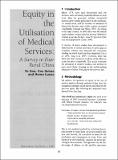| dc.description.abstract | Before 1978, most rural households had low incomes, with a relatively equal distribution at local level. After the economic reforms, household incomes grew rapidly, particularly in the southeastern coastal areas, and the variance in standards of living both between and within regions increased considerably (Ahmad and Wang 1991). According to the State Council, in 1993 there were 80 million rural residents living in absolute poverty (defined in Chinese as jue-dui-pin-hun) , some 8.7 per cent of the total rural population (Chen 1994).
A number of recent studies have documented a deterioration in service provision in poor areas as economic reforms have removed the communal funding on which health facilities depended (Gu et al. 1995; Tang et al. 1994). However, there has been, little direct empirical evidence of the effect on access by poor households. This article examines the utilisation of curative medical care services in poor rural China, focusing on the health-seeking behaviour of those living below the poverty line. | en |

